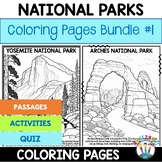108 results
Middle school physical science lectures for Microsoft Word

Chemistry Introduction to Chemistry Guided Notes (Dimensional Analysis + more!)
The 13-page Introduction to Chemistry Guided Notes (Dimensional Analysis, density, temperature scales + more) covers all parts of the first unit of chemistry and has notes/examples/problems that comprehensively covers:Significant figuresScientific notationSystems of measurementDimensional analysisTemperature scales (includes thermometer reading and calculations)DensityAccuracy and precisionPercent errorThe enclosed document is entirely customizable for you add any examples/problems or remove any
Subjects:
Grades:
8th - 11th
Types:
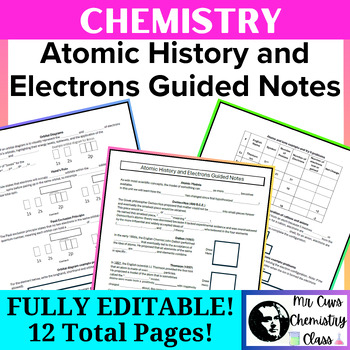
Chemistry Atomic History (Theory) and Electrons Full Unit Guided Notes
The Chemistry (or physical science) 12-page Atomic History (Theory) and Electrons Full Unit Guided Notes (atoms, electrons and electron configurations, orbital diagrams, ions, the electromagnetic spectrum + more!) covers all parts of the listed topics and has notes/examples/problems that comprehensively covers:Atomic Models (Bohr etc.) and Atomic HistoryElectron orbitalsElectron configuration of atoms (longhand and shorthand)Orbital diagrams of atomsLewis structures of atomsConcept of an atom vs
Subjects:
Grades:
8th - 11th
Types:

Chemistry Matter and Basic Atomic Theory Full Unit Guided Notes
The Chemistry (or physical science) 12-page Matter and Basic Atomic Theory Guided Notes (properties, changes, mixtures, phase changes and diagrams, atomic theory + more!) covers all parts of the second unit of chemistry and has notes/examples/problems that comprehensively covers:Basic chemistry concepts - Matter, elements, compounds, pure substances and mixtures including particulate diagrams!Heterogenous and homogenous mixturesChemical and physical propertiesChemical and physical changesKinetic
Subjects:
Grades:
8th - 11th
Types:
![Preview of Chemistry Acids and Bases Full Unit Guided Notes, Examples, Practice [15 pages!]](https://ecdn.teacherspayteachers.com/thumbitem/Chemistry-Acids-and-Bases-Full-Unit-Guided-Notes-Examples-Practice-15-pages--11269401-1710589016/original-11269401-1.jpg)
Chemistry Acids and Bases Full Unit Guided Notes, Examples, Practice [15 pages!]
The 15-page Chemistry Acids and Bases Full Unit Guided Notes Examples, and Practice is entirely customizable. The guided notes are designed to go along with the PowerPoint, but could be used as a stand alone product. This 15 page guided notes set covers all parts of the Acids and Bases unit and has problems that comprehensively cover:Acid-Base vocabulary and propertiesAcid-Base theories Acid nomenclature Concept of strong acids/bases visuallyThe pH Scale Calculations with pH, pOH, [H+] and [OH-]
Subjects:
Grades:
8th - 11th
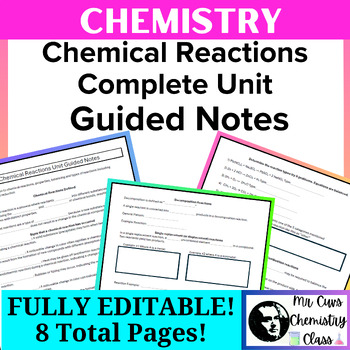
Chemistry Physical Science Chemical Reactions (equations) Full Unit Guided Notes
The 8-page Chemistry Physical Science Chemical Reactions (equations) Full Unit Guided Notes covers all parts of chemical reactions and has notes/examples/problems that comprehensively covers:Basics of chemical reactions including vocabularyBalancing equations step-by-step without polyatomic ionsBalancing equations step-by-step with polyatomic ionsTypes of reactions (synthesis, decomposition, single replacement, double replacement, combustion of organics)Balancing carbon-based combustion reaction
Subjects:
Grades:
8th - 11th
Types:
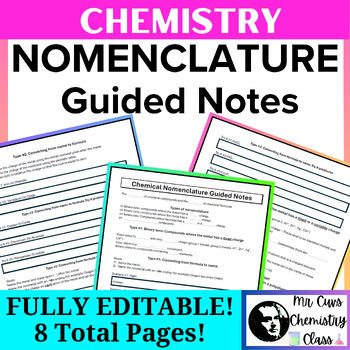
Chemistry Physical Science Chemical Nomenclature Full Unit Guided Notes
The 8-page Chemistry Physical Science Chemical Nomenclature [Naming & Formula Writing (Ionic + Molecular Compounds)] Full Unit guided notes covers all parts of nomenclature and has examples/problems that comprehensively covers:Binary Ionic Nomenclature of metals with a fixed chargeBinary Ionic Nomenclature of metals with a variable chargeTernary ionic compoundsCovalent nomenclature using the prefix system (mono, di, tri etc.)The enclosed document is entirely customizable for you add any exam
Subjects:
Grades:
8th - 11th
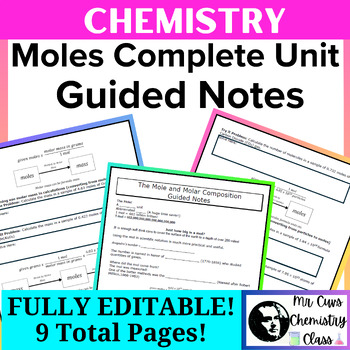
Chemistry Physical Science Moles Molar Composition Full Unit Guided Notes
The 9-page Chemistry Physical Science Moles Molar Composition Full Unit Guided Notes Unit covers all parts of the mole, molar composition and has problems that comprehensively covers:The Mole Molar Mass Molar Mass calculations [Mass to moles (1-step) and Moles to mass (1-step)]Avogadro's number [Particles to moles (1-step) and Mass to particles (2-step) and Particles to mass (2-step)]Percent compositionEmpirical formulas Molecular formulasIf you are interested in a PowerPoint, a review, a test (
Subjects:
Grades:
8th - 11th
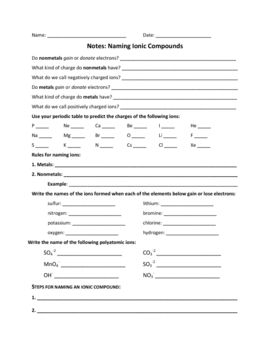
Naming Compounds Notes Set
These notes coincide with the Naming Compounds PowerPoint that is also available. They allow students to follow along with all 4 PowerPoints: Naming Ionic Compounds, Naming Binary Covalent Compounds, Naming Ionic and Covalent Compounds Review and Naming Acids and Bases. They include plenty of student practice that will allow teachers to check for understanding throughout each lesson.
Subjects:
Grades:
8th - 12th
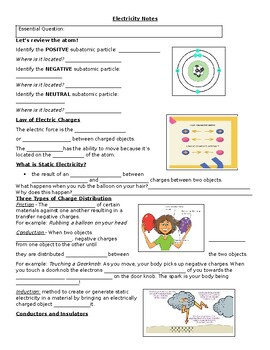
Electricity and Magnetism Notes
Electricity and Magnetism fill in the blank notes. Grab the matching Canva slides on my page as well!
Subjects:
Grades:
8th

StayGiant Physics Bundle: Electricity
Electric Charge, Electric Force, and DC CircuitsSs begin an exploration of electricity by learning about the electric force and the properties and interactions of electric charges. Ss continue by examining electric circuits and the interactions between current, resistance, and voltage.Topics include:Conservation of chargeElectric chargeElectric forceDefinition of a circuitResistivityOhm’s law, Kirchhoff’s loop rule (resistors in series and parallel)Kirchhoff’s junction rule, Ohm’s law (resistors
Subjects:
Grades:
8th - 12th, Higher Education
NGSS:
MS-PS3-2
, HS-PS3-1
, HS-PS3-5
, 4-PS3-2
, HS-PS3-3

Question Exploration: What is acid? What is base? How does the pH scale work?
In Chemistry, adding 1 to 13 equals 7 (and salt) -- when Ss measure the pH of acids, bases and neutrals! What are some general properties of acids, bases, and neutral solutions? How does the pH scale work to rate acidity and alkaline?These Content Enhancement Routines include Question Explorations to ask the Essential Question: What is an acid? What is a base? What is the pH scale? The Concept Comparison Frame contrasts the pH scale and the potential of a substance's solution to form Hydrogen io
Subjects:
Grades:
8th - 10th
NGSS:
HS-PS1-1
, MS-PS1-2
, HS-PS1-7
, HS-PS1-2
, MS-PS1-1
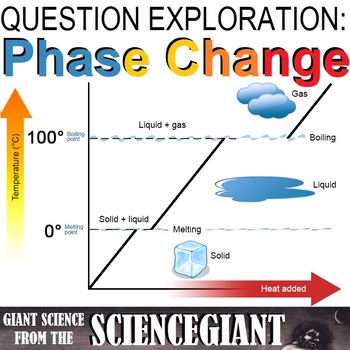
Question Explore: How Does Matter Change State During a Phase Change?
The water cycle is one example of matter changing state, as a liquid evaporates, and the vapor condenses back into a liquid, or freezes into a solid, which precipitates and melts. This question exploration helps Ss explain How Does Matter Change State During a Phase Change?The Question Exploration Routine is an instructional methods that teachers can use to help a diverse student population understand a body of content information by carefully answering a critical question to arrive at a main id
Subjects:
Grades:
7th - 12th
Types:
NGSS:
MS-PS1-4
, MS-PS1-2
, HS-PS1-5
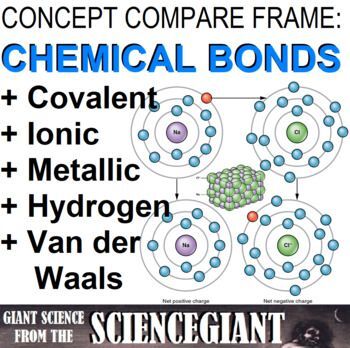
Concept Comparison and Frame: Ionic, Covalent, and Metallic Bonds in Molecules
This concept comparison is between chemical bonding of molecules and compounds. Help Ss contrast ionic and covalent bonding, as well as metallic bonds and Van der Waals forces (hydrogen bonds, dipole-dipole, London dispersion and Debye) . Also includes a chemical bond triangle graphic to help visualize differences in electronegativity The Concept Comparison Routine is used help compare and contrast key concepts. Specifically, students use like and unlike characteristics and categories shared an
Subjects:
Grades:
8th - 10th, Higher Education
NGSS:
HS-PS1-4
, HS-PS1-2
, MS-PS1-1
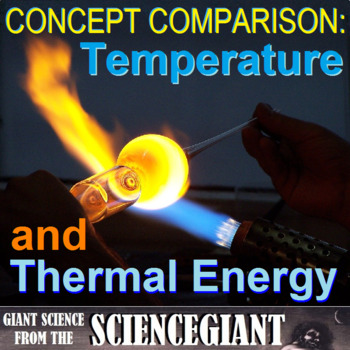
Concept Comparison: Temperature vs Thermal Energy
This Concept Comparison contrasts thermal energy and temperature as they relate to heat transfer. It builds from middle school science concepts of mechanical energy, and an introduces specific heat capacity and the laws of thermodynamics.The Concept Comparison Routine is used help compare and contrast key concepts. Specifically, students use like and unlike characteristics and categories shared and not shared by two or more concepts to better understand the overall concept. Students taught using
Subjects:
Grades:
7th - 12th, Higher Education
NGSS:
HS-PS1-4
, MS-PS1-4
, HS-PS1-5
, MS-PS1-6
Also included in: StayGiant Physics Bundle: Thermal Energy
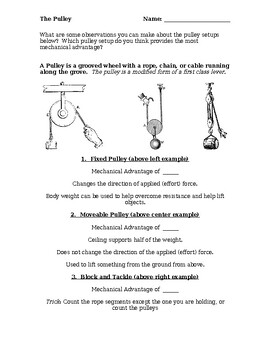
Physics: The Pulley Guided Student Notes (Fixed, Moveable, Block & Tackle)
This MS-Word handout helps guide a lesson on pulleys as part of a physics simple machine unit or Rube Goldberg project. Two levels of guided student notes are provided, the first for limited note taking for special needs students, and the second for typical students who can take full lesson notes. Since this is a word document, you can modify the level of detail you want students to take or fill-in. This is a great handout to use as a lesson exit ticket. The entire handout is can be previewe
Subjects:
Grades:
7th - 10th

Newton's Laws of Motion, Force, and Momentum fill in the blank notes
fill in the blank notes with my powerpoint
Subjects:
Grades:
6th - 12th
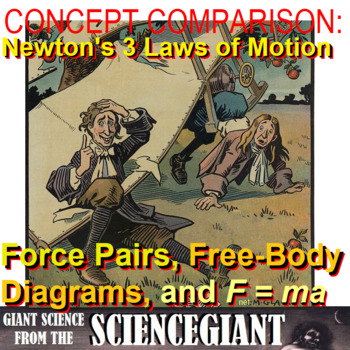
Concept Compare: Newton's Laws of Motion, Force Pairs, and Free-Body Diagrams
This Concept Comparison Frame explores Newton's Laws of Motions and introduces dynamics of unbalanced forces, including the Law of Inertia, F=ma, and action-reaction pairs using many models including free-body diagram and algebra equations.The Concept Comparison Routine is used help compare and contrast key concepts. Specifically, students use like and unlike characteristics and categories shared and not shared by two or more concepts to better understand the overall concept. Students taught usi
Subjects:
Grades:
8th - 12th, Higher Education
NGSS:
MS-PS2-2
, HS-PS2-1
, MS-PS2-5
, MS-PS2-1
, HS-PS2-3
Also included in: StayGiant Physics Bundle: Dynamics

Thermal Energy Transfer and Heating - Conduction, Convection, Radiation
What is the relationship among conduction, convection, and radiation? This concept comparison helps Ss contrast thermal energy transfer methods between solids and fluids, and between objects in contact and being isolated. The Concept Comparison Routine is designed to help students understand concepts by analyzing how they are the same and how they are different. Through use of the routine, teachers and students explore the characteristics of two or more concepts, identify the characteristics tha
Subjects:
Grades:
7th - 11th, Higher Education
Also included in: StayGiant Physics Bundle: Thermal Energy
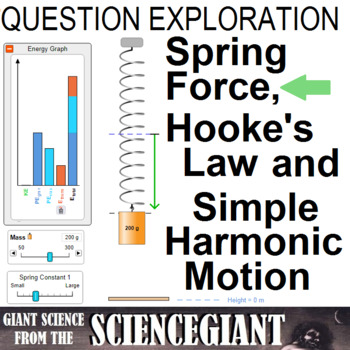
Question Exploration: Spring Force, Hooke's Law and Simple Harmonic Motion
This Question Exploration helps Ss answer the question: How does a spring scale work? Ss will identify conditions of simple harmonic motion and relate to Hooke's Law to find the spring force and spring constant. Ss will also examine the relationship between the amount a linear spring is stretched and the restoring force that acts to return the spring to its rest length. This concept is central to an understanding of elastic potential energy in mechanical systems and has implications in the study
Subjects:
Grades:
8th - 11th, Higher Education
NGSS:
HS-PS2-2
, HS-PS2-1
, HS-PS2-6
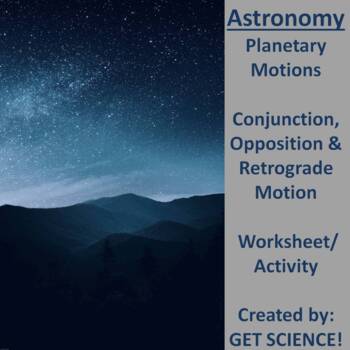
Planetary Motions: Conjunction, Opposition & Retrograde Motion
This worksheet should be used simultaneously with the free PowerPoint presentation titled "Planetary Motions". The PowerPoint walks the students through the meanings of Conjunction, Opposition and Retrograde motion. Examples, pictures and animations are used for better understanding. The planets and the Moon are used as examples and students will need to draw on a diagram to show their understanding. This lesson can be edited and the answer key is provided.The PowerPoint has animations that a
Subjects:
Grades:
8th - 12th, Higher Education
Types:
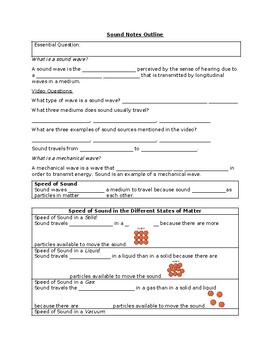
Sound Notes Outline
This Sound Notes outline matches my Sound Notes Canva. These are fill in the blank notes for students in 8th grade physical science.
Subjects:
Grades:
8th
Also included in: Sound Notes and Sound Outline Notes
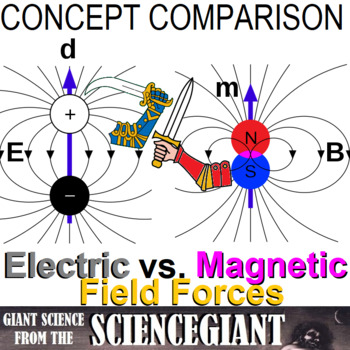
Concept Comparison: Electric Fields vs Magnetic Fields
Electric and magnetic fields are both components of an electromagnetic field. But is it just as simple as saying to Ss magnetic effect is caused by moving electric charges while an electric field is caused by stationary charges? Nope! This concept comparison helps Ss contrast Electric Fields (E) versus Magnetic Fields (B).Concept Comparison Routine is used help compare and contrast key concepts. Specifically, students use like and unlike characteristics and categories shared and not shared by t
Subjects:
Grades:
7th - 12th
Also included in: StayGiant Physics Bundle: Magnetism and Electromagnetism

Question Exploration: What is Static Electricity? What are Electric Charges?
What is static electricity? This Question Exploration helps Ss explains how objects become electrically charged, and contrasts conductors with insulators. Question Exploration Routines are an instructional method that teachers can use to help a diverse student population understand a body of content information by carefully answering a critical question to arrive at a main idea answer. Students taught using Content Enhancement earned higher total test scores than did students taught using the l
Subjects:
Grades:
8th - 12th
NGSS:
MS-PS3-2
, HS-PS3-1
, HS-PS3-5
Also included in: StayGiant Physics Bundle: Electricity

Earth's Motions Bundle w/Key
This bundles includes power point presentations and scaffolded/guided notes for all lessons which include: Earth's Rotation, Earth's Revolution, and Celestial Sphere. Altitude of the Noon Sun lab/activity/investigation and Rotation Revolution Exam. Bonus: sun's path diagram worksheet which can be used in addition to the celestial sphere lesson or a springboard from the lesson. It has 15 questions following the activity. Kindly leave a review of my work, it will help me create future products.
Subjects:
Grades:
6th - 12th, Higher Education, Adult Education, Staff
Types:
Showing 1-24 of 108 results


